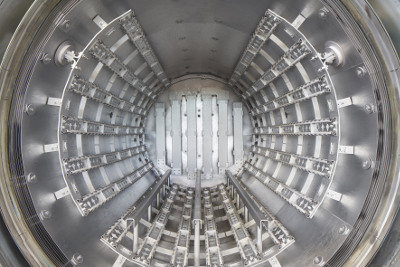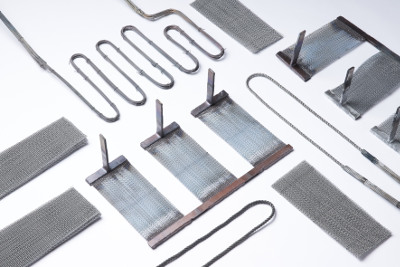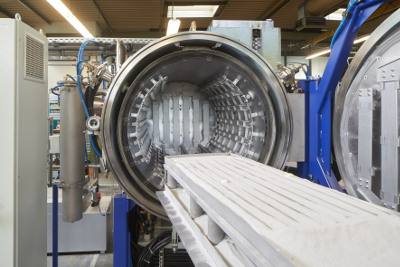Fully metallic furnaces with tungsten heating elements make high product quality possible at 2800 °C
High-temperature furnaces must withstand high temperatures that melt materials, such as titanium, without damage. Usually made of graphite, these furnaces frequently cause contamination with reactive carbon which can cause damage to the manufactured products. Fully metallic furnaces and heating elements made of suitable materials on the other hand are a clean solution. Tungsten for example is one of the few materials that causes no contamination in a suitable atmosphere. With a melting point of 3400 °C, temperatures up to 2800 °C can be reached in the high-temperature furnace with tungsten. The material is dimensionally stable, creep-resistance and durable. Only because tungsten is difficult to process has this material not long since become the accepted standard. The Gesellschaft für Wolfram Industrie mbH has specialised in the processing and tailor-made delivery of heating elements made of tungsten and also molybdenum according to the specifications of the respective furnace manufacturers. In addition, the characteristics of the heating elements can be adapted to individual requirements through non-sag doping and the addition of rare earths.

High-temperature furnaces are essential for smelting various materials in industrial applications. “Some of these materials, such as titanium, have a melting point of 1668 °C,” explains Dipl.-Ing. Wolfgang Jung, the metal expert responsible for research and development at the Gesellschaft für Wolfram Industrie mbH. “This is a major challenge for fully metallic furnaces and heating elements, because they are regularly exposed to high temperatures and have to stand up to that without getting damaged.”
Choice of heating elements depends on conditions in the furnace
The choice of materials used as heating elements is therefore influenced to a large extent by the temperature range and atmosphere they can be used in. When tungsten for example is used in an oxidising atmosphere, tungsten oxide forms and the heating element deteriorates. That is why welding with tungsten is only possible in a protective gas atmosphere or reducing atmosphere, otherwise the material breaks down.
Tungsten heating elements are used in a hydrogen atmosphere, especially for high-temperature applications in the range of 1600 to 2000 °C because the melting point of tungsten is 3400 °C. Due to its low vapour pressure and the related property of very low vaporisation even at high temperatures, furnaces with tungsten can reach temperatures between 2600 and 2800 °C, even in a high vacuum. “The material is dimensionally stable, resistant to corrosion, creep resistant and durable. Depending on the process, application and handling, the durability is up to five times as high compared to other materials thanks to the high surface loading capacity,” says Jung. Processing it however is difficult.

High corrosion resistance and dimensional stability of tungsten and molybdenum
Molybdenum, another material suitable for high-temperature furnaces that is mainly used in the glass industry, can serve as an alternative because it does not stain during smelting. Its properties do not differ significantly from those of tungsten. The high-strength, tough and hard metal is a glossy, silvery white. Molybdenum is also dimensionally stable, resistant to corrosion and durable. Like tungsten, it is used for heating elements in a reducing atmosphere for high-temperature applications. However, molybdenum is much more ductile than tungsten so it can be shaped and joined with less effort. Note that molybdenum has a melting point of 2600 °C, considerably lower than tungsten. Accordingly molybdenum is used mainly for applications where its melting point is sufficient to obtain the benefit of easier processing. Heating elements made of molybdenum become unstable due to their creep characteristics starting at a temperature of 2000 °C. Using tungsten is therefore recommended in such cases.
Also the material should cause next to no contamination that could put product quality at risk. Note that gases, furnace materials and heating elements can influence each other. Vaporising elements from the furnace materials can accelerate the corrosion and breakdown of the heating elements. Using tungsten on the other hand produces neither oxygen nor moisture or carbon, so that high product quality without contamination is assured. The material is preferred for heating elements, heating cables and combustion boats in full metal furnace construction. Used heating elements can also be returned to the Gesellschaft für Wolfram Industrie mbH and the residual material value is refunded. The elements are shredded, them processed into ammonium tungstate using a chemical extraction process and subsequently into tungsten powder using a reduction process, so the tungsten can be used in the production of other products such as medical technology shielding.
Addition of rare earths improves heating element properties
The properties of tungsten and molybdenum heating elements can also be adapted to individual requirements through non-sag doping and the addition of rare earths. “Rare earth metals can for example be used to further increase the temperature stability, so that the recrystallization of the microstructure only occurs at higher temperatures. This delays the embrittlement of the material,” Jung explains. “Using rare earths also minimises grain boundary sliding, considerably increasing the product’s creep resistance.” The Gesellschaft für Wolfram Industrie offers special forms as well as all metal and hybrid versions. All products distinguish themselves with the highest purity.

